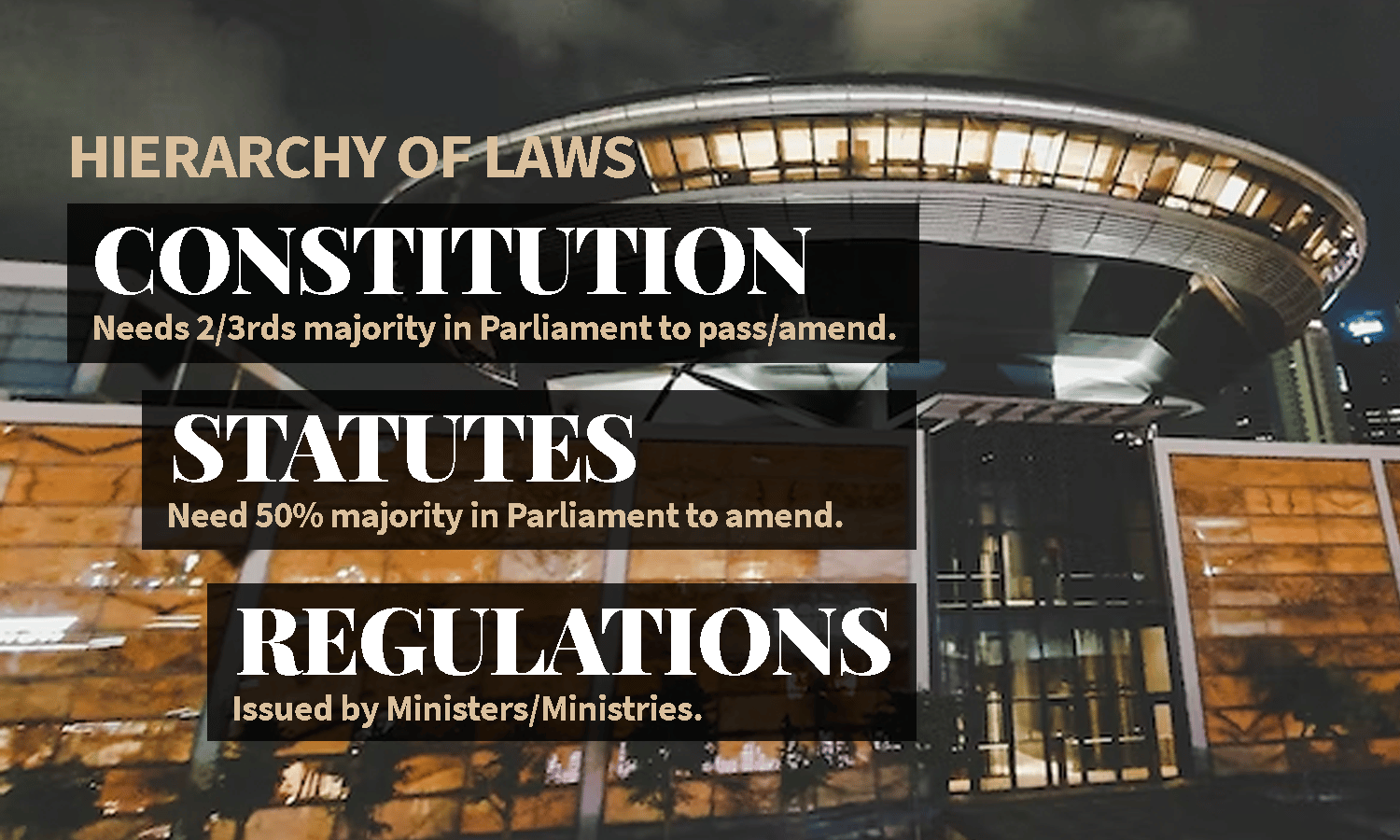EXPLAINER: Constitutional amendments and the definition of marriage in the Women’s Charter
Salt&Light // August 22, 2022, 11:30 pm

At the National Day Rally on Sunday 21 August, Prime Minister Lee Hsien Loong announced that while Section 377A would be repealed, the definition of marriage as between a man and a woman will be given additional Constitutional protection against a legal challenge.
Salt&Light asked lawyers to explain the legal technicalities and implications to the common man.
1. How is marriage defined in the Interpretation Act and the Women’s Charter? Is there any difference?
For non-Muslims, the legal definition of marriage is contained in two main laws, the Interpretation Act and the Women’s Charter.
The Interpretation Act defines a “monogamous marriage” as “a marriage which is recognised by the law of the place where it is contracted as a voluntary union of one man and one woman to the exclusion of all others during the continuance of the marriage”.
The Women’s Charter sets out various restrictions and circumstances where a marriage is considered “void”. Section 12(1) of the Women’s Charter provides that: “A marriage solemnised in Singapore or elsewhere between persons who, at the date of the marriage, are not respectively male and female is void.”
However, the Women’s Charter also makes clear that a person who has gone a sex reassignment procedure is considered to be the opposite sex. Hence, for example, a man who has gone through a sex reassignment procedure is considered to be a “woman”, and may marry a man.
Marriage between Muslims is governed by the Administration of Muslim Law Act (AMLA).
2. What is the link between the Interpretation Act, the Women’s Charter and the Constitution?
Laws are arranged in a hierarchy.
The Constitution is the highest law of the land. It allocates the powers of government, and also protects certain fundamental rights. All laws and government actions must be consistent with the Constitution, otherwise they are void or unconstitutional (i.e. “illegal” laws or government actions). A person whose rights have arguably been infringed can challenge such laws or government actions in court.
The Constitution can only be amended by a “super-majority” of two-thirds vote in Parliament.
Below the Constitution are ordinary laws such as the Interpretation Act, Women’s Charter and Penal Code.
These can be amended by majority vote (i.e. more than 50%) in Parliament.
At the lowest level are subsidiary legislation, known as regulations.
These are usually issued by Ministers or ministries, and govern specialised or specific details regarding certain policies.
3. Can the Constitution be amended to protect the definition of marriage? How?
There are at least a few ways to amend the Constitution to protect the definition of marriage, such as the following.
The first option is to directly enshrine the definition of marriage in the Constitution.
This can be done, for example, by writing directly into the Constitution a line to state that “Only marriage between a man and a woman shall be recognised in Singapore”, or copying the definition of marriage from the Interpretation Act and the Women’s Charter into the Constitution.
The second option is somewhat more indirect, which is to shield the existing definitions under the Interpretation Act and the Women’s Charter from legal challenge.
This can be done, for example, by stating to the effect that: “The definition of marriage shall be set out in the Interpretation Act and the Women’s Charter, and that these laws shall not be challenged in the courts.”
Beyond these options, there are potentially many other possibilities that can be adopted.
4. When such amendments are made to the Constitution, can the definition of marriage still be changed or challenged in future?
Depending on how the Constitution will be amended, the definition of marriage can still be changed or challenged.
If the first option is taken, to directly enshrine the definition of marriage in the Constitution: The definition of marriage can be changed or challenged by passing a constitutional amendment by a “super-majority” of two-thirds vote in Parliament.
If the second option is taken, to shield the existing definitions under the Interpretation Act and the Women’s Charter from legal challenge: The definition of marriage can be changed or challenged by passing an amendment to the Interpretation Act or Women’s Charter or both, by a majority vote (more than 50%) in Parliament.
5. How is amending the Constitution, as proposed in the National Day Rally, different from enshrining the definition of marriage in the Constitution? What are the implications?
At the National Day Rally, Prime Minister Lee Hsien Loong said: “We will therefore protect the definition of marriage from being challenged constitutionally in the courts. The legal definition is contained in the Interpretation Act and the Women’s Charter. We have to amend the Constitution to protect it, and we will do so.”
Law and Home Affairs Minister K Shanmugam also added that the Government will make clear in the Constitution that it is Parliament’s prerogative to define marriage as being between a man and a woman and to make other pro-family policies on that basis. He added that this is different from enshrining the definition of marriage in the highest law of the land.
This means that the Government will not directly enshrine the definition of marriage in the Constitution.
There are two key implications.
The first implication is that the definition of marriage will be easier to change than if marriage were directly enshrined in the Constitution.
Unlike a constitutional amendment which requires a two-thirds majority in Parliament, this definition of marriage can still be changed by passing an amendment to the Interpretation Act or Women’s Charter or both, by a majority vote (more than 50%) in Parliament.
The second implication is that the definition of marriage may not occupy the same level of priority in law and policy, than if marriage were directly enshrined in the Constitution.
This is because the definition of marriage would only be contained in ordinary laws, as opposed to the Constitution, which is the highest law of the land.
6. Does amending the Constitution as proposed in the National Day Rally afford greater protection to safeguarding marriages and families as compared to the situation now? Why/Why not?
In Singapore, our definition of “family” is linked to marriage.
In the words of the Prime Minister during the National Day Rally: “By and large, Singapore is a traditional society, with conservative social values. We believe that marriage should be between a man and a woman, children should be born and raised within such families, the traditional family should form the basic building block of our society.”
Amending the Constitution in the manner as proposed at the National Day Rally will still afford greater protection to safeguard the current definition of marriage and family, compared to the situation now.
There is currently no provision in the Constitution which covers the definition of marriage. Marriage is only defined at the level of ordinary laws, in the Interpretation Act and Women’s Charter.
This means that, currently, it is possible to bring legal challenges against the definition of marriage in those laws, and to argue that they violate various rights under the Constitution.
Someone can theoretically bring a legal challenge to argue that the definition of man-woman marriage discriminates against same-sex couples and thus violates the right to equality (as per Article 12 of the Constitution). However, this is different from saying that the legal challenge will succeed, because the question will ultimately have to be decided by the courts in such an event.
7. How is protecting the definition of marriage from being challenged in courts different from protecting it from being challenged in Parliament?
In Singapore, the courts interpret the law, while Parliament makes the law.
Our courts adopt an “adversarial” process, which is based on one party versus another party. Third parties are rarely allowed to be involved in the process. A judge or group of judges will then decide the issues in the case.
This process allows judges to potentially decide hotly-contested questions in a win-lose fashion. Our Singapore courts have recognised these dangers, and have repeatedly emphasised that the role of the courts is only to interpret the law and not to overstep their boundaries.
This is not the case in other countries. For example, in the United States, courts have repeatedly entered into the “culture wars” and decided controversial questions one way or another. In 2015, the US Supreme Court legalised same-sex marriage throughout the country, with a majority of 5 to 4 judges voting in favour.
The decision to leave the definition of marriage to be decided by Parliament is meant to preserve the democratic process, and allow such controversial social and moral questions to be addressed through the normal law-making processes.
8. How might these proposed Constitutional changes affect us in the future?
If and once the legal changes are made according to the Prime Minister’s announcements, it would mean that questions such as whether or not to legalise same-sex marriage would be a matter for Parliament to decide in the future, not the courts.
This would mean that citizens will have to learn to dialogue and embark on the (sometimes challenging but often meaningful) task of persuading one another (and politicians) of their views and perspectives on the way forward on matters of law, policy and society.
They can and must exercise their rights of freedom of speech, freedom of religion and right to vote wisely and in accordance with the law.
We are an independent, non-profit organisation that relies on the generosity of our readers, such as yourself, to continue serving the kingdom. Every dollar donated goes directly back into our editorial coverage.
Would you consider partnering with us in our kingdom work by supporting us financially, either as a one-off donation, or a recurring pledge?
Support Salt&Light




